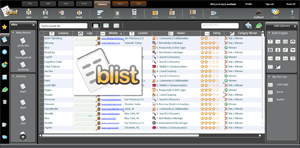I recently had the opportunity to see a demo of a product coming out in early 2008 called Blist (pronounced like “bliss” with a “t” at the end) that will take on DabbleDB and Trackvia by giving users the tools to easily create and manage databases online.
Blist’s initial target demographic will be Excel users who need more functionality and are trying to make their spreadsheets act like databases, but who don’t have the skills or tolerance to even use Access. Blist will not require users to know any SQL, the language commonly used for interacting with databases (in contrast, recently reviewed Zoho DB does require knowledge of SQL). The company behind Blist seeks to eventually replace traditional databases completely by making its product robust and appealing enough for database application developers as well. The end result: no more databases behind the firewall, since they all end up existing in the cloud.
Blist’s plans are obviously ambitious. They are not only designing a better user interface for manipulating databases, they are also building a sophisticated database architecture that will allow them to replicate data geographically, thereby preventing data loss from natural disasters. Their entirely SaaS-based database solution will also provide an API so you can link your applications up with it. If Blist ever has a chance of replacing traditional database servers, its API will need to be very capable indeed so that applications can run all of the same queries they run now. Blist’s CEO Kevin Merritt says that the API will eventually allow for a large range of operations, but the initial API will be fairly simple and will rely on XML.
Since Blist won’t be ready to convert database administrators right off the bat, the quality of its user interface will determine its initial success. Either Blist will come across as intuitive and succeed, or non-technical users will go right back to using Excel. From the brief demonstration I saw, Blist does look impressively easy to use and very functional, too. As you might be able to tell from the screenshots – which show how Blist could have been used to organize our candidate data for the TechCrunch40 conference – the program looks and feels more like a full-fledged desktop application than DabbleDB. It currently supports fourteen data types, with more coming soon. Data can be viewed in table mode (as in Excel), page view (so you can edit entries using a form), or calendar view (so you can see entries with associated dates in a calendar layout).
What really makes Blist a database application is the ability to apply various “lenses”, or views, to the data. These lenses are like queries since they allow you to view the data by particular criteria. But you won’t need to know any syntax: just change the fields in a form to construct your query. Right now, lenses can only be used to view data in different ways. Blist will become much more useful, in my mind, when users can also implement lenses to manipulate data. Once that is possible, it will closely match the functionality of GUI database tools like MySQL Query Browser.
Since Blist is an online application, the company has taken care to integrate features that distribute and share data. Databases in Blist can be easily shared with other Blist users through the standard interface. They can also be spread over the internet via widgets that pull out samples of data from particular databases. If you are a blogger who wants to publish some of the raw data you have used for analysis, you’ll be able to drop a Blist widget into your post that will highlight some of the main data points and allow users to gain access to the original data set. For example, I wouldn’t have to make unwieldy charts like this one for white label social networking solutions, because I could just drop in a Blist widget with all the data and viewing capabilities instead. These widgets, like most, can also be embedded on other webpages across the net.
While Blist is gunning for the $15 billion relational database market, they have not yet figured out pricing (although they do intend to charge both casual consumers and business users). The company will start by focusing on the North American market and will move to other regions from there. Blist has not accepted any external funding yet but will be looking to raise some soon.



